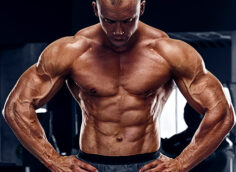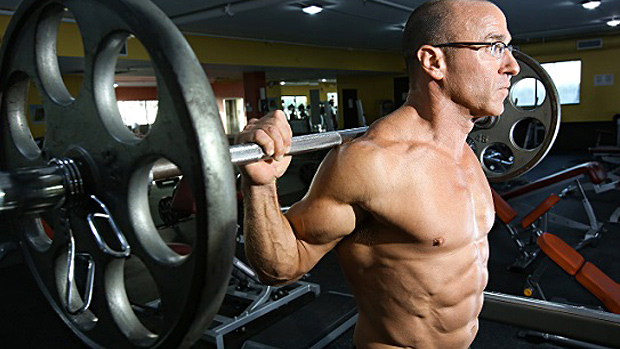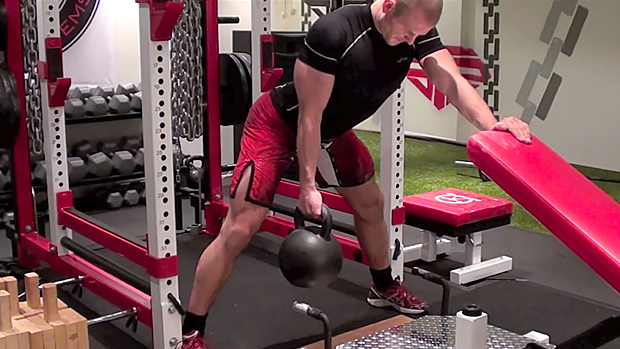Maximize Your Chest Workout
Not a competitive powerlifter? Then stop training like one. Don't mistake the fundamentals of powerlifting for the fundamentals of strength training. There's a difference. I go into more detail in my book, Strength Zone Training: The Most Effective Method for Maximizing Muscle Development, but for now, let's look at some surefire tips to maximize your chest workout for size and strength.
When using a barbell, placing your feet on the floor gives you a wider base of support to control minor deviations. It also helps prevent major deviations that could end up as a YouTube fail video.
But it's a different story when doing a dumbbell bench press. The control requirements are different. Many people feel more comfortable with their feet on the bench. It's more about your individual arm stability than the risk of being pulled off the bench. So, unless you prefer your feet on the floor, try placing your feet on the bench when using dumbbells.
Not convinced? One study compared muscle activation during a bench press with the feet on the ground (conventional) to feet off the ground with active hip flexion and 90-degrees of knee flexion. This study used men who had four years of experience in strength training and had performed the traditional bench press before. The researchers found the feet-up bench press had better muscle activation in every muscle group analyzed (1).
But the main reason to dumbbell press with your feet on the bench? It requires you to use your upper-body pushing musculature instead of getting help from the lower body.
What about putting your feet in the air like a baby getting a diaper change? You can do that, but holding your feet in the air takes some extra effort, which takes away effort from where you want it – the pressing muscles.
Varying the bench angle during pressing exercises biases activation in either the sternal (lower) or clavicular (upper) portion of the pecs.
- Muscle activation of the sternocostal head (lower) of the pectoralis major was significantly greater during the flat and decline bench press.
- Activation of the clavicular head (upper) was significantly greater on an inclined bench at 44-degrees and 56-degrees of incline (2,3,4).
Although the inclined angle does increase upper pec activation, it seems the sweet spot is to have the bench at an inclined 30-degrees. This angle produces greater upper pec activation, whereas having the bench at a 45-degree angle or more produces significantly higher activation of the anterior deltoid and decreases the muscular performance of your pecs (5).
The NT Loop push-back push-up is a challenging bodyweight and band exercise you can do at the gym, at home, or on the go.
This is different from a dive bomber push-up because you're keeping your hips lower, making it more like an incline press. The addition of the bands provides accommodating resistance that makes each rep more productive.
It's an alternative to an incline press that makes the shoulders work hard to drive your body back using a natural arc and push angle.
Try the dumbbell decline hip-bridge press. The standard decline bench press is awkward when you're holding heavy dumbbells. To solve this problem, get on the floor and elevate your hips. This puts your torso at a decline angle relative to the dumbbells.
I like the floor press because you can bend your knees like your feet are on a bench, except there's no risk of falling off a bench if you tilt the bar.
Using a thick pad under your mid-torso increases the productive range of motion while offering a few additional safety benefits. There's no risk of the bar crushing your neck if you drop the weight because the plates will hit the floor first. It's also easier to spot. You can also raise your hips and do a barbell decline press to mix up your angles.
Side push-ups are an old-school bodyweight move that really hit your inner pecs. You can hold a dumbbell if you need to add some additional load.
This exercise is traditionally done for the triceps with the hand on the floor and your forearm angled. Elevate your hand on a dumbbell and keep a more vertical forearm angle to hit your pecs in the shortened range. You'll push your arm across the midline of your body instead of simply extending at your elbow.
Presses in the flat, decline, and incline positions all create the most mechanical tension on the pecs when the humerus (upper arm bone) is parallel to the ground, which is in the lengthened-to-midrange strength zone.
However, these exercises provide little mechanical tension on your pecs when your wrists are directly in front of your shoulders, which is in the shortened-to-midrange strength zone of your pecs. That's what I mean when I say "inner pecs."
It's important to include an exercise in the shortened-to-midrange zone that forces your pecs to deal with a large load (relative to your current strength level) when your hands are directly in front of your shoulders and torso. This trains your body in the strength zone missed by the compound pressing exercises, and you get stronger pecs in all positions of horizontal and diagonal arm adduction (moving your arm from out to in).
- Muyor JM et al. Evaluation and comparison of electromyographic activity in bench press with feet on the ground and active hip flexion. PLoS One. 2019 Jun 14;14(6):e0218209. PubMed.
- Saeterbakken AH et al. The effects of bench press variations in competitive athletes on muscle activity and performance. J Hum Kinet. 2017 Jun 22;57:61-71. PubMed.
- Trebs AA et al. An electromyography analysis of 3 muscles surrounding the shoulder joint during the performance of a chest press exercise at several positions. J Strength Cond Res. 2010 Jul;24(7):1925-30. PubMed.
- Barnett C et al.a Effects of variations of the bench press exercise on the EMG activity of five shoulder muscles. J Strength Cond Res. 1995 Nov;9(4):222-7.
- Rodríguez-Ridao D et al. Effect of Five Bench Inclinations on the Electromyographic Activity of the Pectoralis Major, Anterior Deltoid, and Triceps Brachii during the Bench Press Exercise. Int J Environ Res Public Health. 2020;17(19):7339. PubMed.
T Nation earns from qualifying purchases as an Amazon Associate. Read more about our policy.




